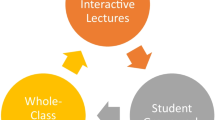Abstract
Although official curriculum documents make cursory mention of the need for problem posing in school mathematics, problem posing rarely becomes part of the implemented or assessed curriculum. This paper provides examples of how problem posing can be made an integral part of mathematics teacher education programs. It is argued that such programs are a good place to start the process of redesigning mathematics curricula so that school mathematics will pay more than lip service to problem posing. Data are presented and analyzed showing that teacher education students can recognize the need for problem posing both in their own programs and in school mathematics curricula. Examples of problems posed by teacher education students are presented and discussed. An active learning framework for interpreting the role of problem posing in mathematics classrooms is presented.





Similar content being viewed by others
References
Belfield, H. H. (1887). Revised model elementary arithmetic. Chicago, IL: Geo. Sherwood and Co.
Bernardo, A. B. I. (1998, August). Analogical problem construction: A study on an instructional intervention for improving analogical transfer in word problems. Paper presented at the 5th De La Salle University Lecture Series, Manila.
Brown, S. I., & Walter, M. I. (1983). The art of problem posing. Philadelphia, PA: Franklin Institute Press.
Cai, J., & Brooke, M. (2006). New perspectives of looking back in mathematical problem solving. Mathematics Teaching, 196, 42–45.
Cai, J., & Nie, B. (2007). Problem solving in Chinese mathematics education: Research and practice. ZDM—International Journal on Mathematics Education, 39, 459–475.
Cankoy, O., & Darbaz, S. (2010). Effect of a problem posing-based problem-solving instruction on understanding problems. Hacettepe Universitesi Journal of Education, 38, 11–24.
Chapman, O. (2011). Prospective elementary school teachers’ ways of making sense of mathematical problem posing. In B. Ubuz (Ed.), Proceedings of the 35th Conference of the International Group for the Psychology of Mathematics Education (Vol. 2, pp. 209–216). Ankara, Turkey: PME.
Del Campo, G., & Clements, M. A. (1987). A manual for the professional development of teachers of beginning mathematicians. Melbourne, Australia: Catholic Education Office of Victoria/Association of Independent Schools of Victoria.
Einstein, A., & Infeld, L. (1938). The evolution of physics from early concepts to relativity and quanta. New York, NY: Simon & Schuster.
Ellerton, N. F. (1986). Children’s made-up mathematics problems: A new perspective on talented mathematicians. Educational Studies in Mathematics, 17(3), 261–271.
Hashimoto, Y. (1987). Classroom practice of problem solving in Japanese elementary schools. In J. P. Becker & T. Miwa (Eds.), Proceedings of the U.S.–Japan Seminar on Mathematical Problem Solving (pp. 94–119). Columbus, OH: ERIC/SMEA Clearinghouse.
Kilpatrick, J. (1987). Problem formulating: Where do good problems come from? In A. H. Schoenfeld (Ed.), Cognitive science and mathematics education (pp. 123–147). Hillsdale, NJ: Erlbaum.
Lortie, D. (1975). Schoolteacher: A sociological study. Chicago, IL: University of Chicago Press.
National Council of Teachers of Mathematics. (2000). Principles and standards for school mathematics. Reston, VA: Author.
National Governors Association Center for Best Practices, Council of Chief State School Officers. (2012). Common core state standards for mathematics. Washington, DC: Author.
Schoenfeld, A. H. (1989). Teaching mathematical thinking and problem solving. In L. B. Resnick & L. E. Klopher (Eds.), Toward the thinking curriculum: Current cognitive research (pp. 83–103). Alexandria, VA: Association for Supervision and Curriculum Development.
Silver, E. A., & Cai, J. (1996). An analysis of arithmetic problem posing by middle school students. Journal for Research in Mathematics Education, 27(5), 521–539.
Silver, E. A., Kilpatrick, J., & Schlesinger, B. (1990). Thinking through mathematics: Fostering inquiry and communication in mathematics classrooms. New York, NY: The College Entrance examination Board.
Silver, E. A., & Mamona, J. (1989). Problem posing by middle school teachers. In C. A. Maher, G. A. Goldin, & R. B. Davis (Eds.), Proceedings of the Eleventh Annual Meeting of the North American Chapter of the International Group for the Psychology of Mathematics Education (pp. 263–269). New Brunswick, NJ: PME-NA.
Staebler-Wiseman, H. A. (2011). Problem posing as a pedagogical strategy: A teacher’s perspective. Ph.D. dissertation, Illinois State University.
Stoyanova, E., & Ellerton, N. F. (1996). A framework for research into students’ problem posing in school mathematics. In P. Clarkson (Ed.), Technology in Mathematics Education (pp. 518–525). Melbourne, Australia: Mathematics Education Research Group of Australasia.
Taylor, P. M. (2002). Implementing the standards: Keys to establishing positive professional inertia in preservice mathematics teachers. School Science and Mathematics, 102, 137–142.
Acknowledgment
The author gratefully acknowledges the willing participation of the students involved in this study.
Author information
Authors and Affiliations
Corresponding author
Rights and permissions
About this article
Cite this article
Ellerton, N.F. Engaging pre-service middle-school teacher-education students in mathematical problem posing: development of an active learning framework. Educ Stud Math 83, 87–101 (2013). https://doi.org/10.1007/s10649-012-9449-z
Published:
Issue Date:
DOI: https://doi.org/10.1007/s10649-012-9449-z




